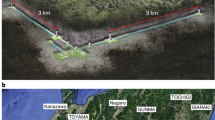Abstract
The AnaBHEL experiment aims to detect the analog Hawking radiation emitted by an accelerated relativistic plasma mirror for which the effective event horizon is analogous to that of a black hole, thanks to the equivalence principle. This radiation is composed of a few Hawking photons emitted simultaneously in the infrared band and the ‘partner photons’ in the ultraviolet band. The former is emitted in the opposite direction of the mirror propagation and is redshifted in the laboratory frame. In the AnaBHEL scheme, high-intensity petawatt laser pulses, will be used to produce the relativistic accelerated plasma mirrors from a helium gas jet. Infrared and ultraviolet photons generated by the mirrors will be detected by dedicated superconducting nanowire single-photon detectors (SNSPDs) at very low temperature and by multichannel plates at room temperature, respectively. Details of the setup design are discussed.

Similar content being viewed by others
References
S.W. Hawking, Particle creation by black holes. Commun. Math. Phys. 43, 199 (1975)
S.W. Hawking, Breakdown of predictability in gravitational collapse. Phys. Rev. D 14, 2460–2473 (1976)
D.N. Page, Information in black hole radiation. Phys. Rev. Lett. 71, 3743 (1993)
D.N. Page, Average entropy of a subsystem. Phys. Rev. Lett. 71, 1291 (1993)
A. Almheiri, D. Marolf, J. Polchinski, J. Sully, Black holes: Complementarity or firewalls? J. High Energy Phys. 2, 62 (2013)
A. Almheiri, D. Marolf, J. Polchinski, D. Stanford, J. Sully, An apologia for firewalls. J. High Energy Phys. 9, 18 (2013)
P. Chen, Y.C. Ong, D.N. Page, M. Sasaki, D. Yeom, Naked black hole firewalls. Phys. Rev. Lett. 116, 161304 (2016)
K. Skenderis, M. Taylor, The fuzzball proposal for black holes. Phys. Rep. 467, 117 (2008)
P. Chen, Y.C. Ong, D. Yeom, Black hole remnants and the information loss paradox. Phys. Rep. 603, 1–45 (2015)
P. Chen et al., (AnaBHEL), “AnaBHEL (analog black hole evaporation via lasers) experiment: concept, design, and status.” Photon. 9, 1003 (2022). (arXiv:2205.12195)
P. Chen, G. Mourou, Accelerating plasma mirrors to investigate black hole information loss paradox. Phys. Rev. Lett. 118, 045001 (2017). (arXiv:1512.04064)
P. Chen, G. Mourou, Trajectory of a flying plasma mirror traversing a target with density gradient. Phys. Plasmas 27, 123106 (2020). (arXiv:2004.10615)
Y.-K. Liu (on behalf of the AnaBHEL collaboration) invited talk at LPHYS’23 31st Annual International Laser Physics Workshop seminar 9 at 10:25–10:50 https://www.lasphys.com/workshops/lasphys23/
J. Bortfeldt et al., NIM A 903(21), 317–325 (2018)
H.-Y. Wu, PhD thesis at National Taiwan University (2023), http://tdr.lib.ntu.edu.tw/jspui/handle/123456789/89977https://doi.org/10.6342/NTU202303179
V.B. Verma et al., Single-photon detection in the mid-infrared up to 10 μm wavelength using tungsten silicide superconducting nanowire detectors. APL Photon. 6(5), 056101 (2021)
K. Bergren, Superconducting nanostrip detectors: from quantum communications to dark-matter search. J. Low Temp. Phys. (Submitted)
O.V. Lounasmaa, Experimental Principles and Methods Below 1K (Academic Press Inc, 1997)
Infrared Bandpass Filters – IR Bandpass Filters | Edmund Optics => https://www.edmundoptics.fr/p/100m-cwl-250nm-diameter-050m-fwhm-ir-banpass-filter/45231/
X.-F. Navick et al., A tunable blackbody polarized infrared source for the BBOP camera. J. Low Temp. Phys.(Submitted)
A.S. Pirozhkov et al., Approaching the diffraction-limited, bandwidth-limited Petawatt. Opt. Exp. 25(17), 20486 (2017)
H. Kiriyama et al., Laser output performance and temporal quality enhancement at the J-KAREN-P Petawatt laser facility. Photonics 10, 997 (2023)
Author information
Authors and Affiliations
Consortia
Contributions
XN wrote the main manuscript text and prepared figure 2. Figure 1 has been produced within the AnaBHEL collaboration (see references). Many members of the collaboration reviewed the present paper
Corresponding author
Ethics declarations
Competing interests
The authors declare no competing interests.
Additional information
Publisher's Note
Springer Nature remains neutral with regard to jurisdictional claims in published maps and institutional affiliations.
Rights and permissions
Springer Nature or its licensor (e.g. a society or other partner) holds exclusive rights to this article under a publishing agreement with the author(s) or other rightsholder(s); author self-archiving of the accepted manuscript version of this article is solely governed by the terms of such publishing agreement and applicable law.
About this article
Cite this article
Navick, XF., for the AnaBHEL Experiment. Design of the Setup for the AnaBHEL Experiment. J Low Temp Phys 214, 158–163 (2024). https://doi.org/10.1007/s10909-023-03032-7
Received:
Accepted:
Published:
Issue Date:
DOI: https://doi.org/10.1007/s10909-023-03032-7




